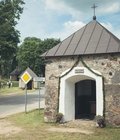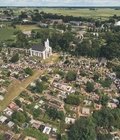There are 19 Chapels of the Cross at the Samogitian Calvary. A path measuring 7 kilometres dedicated to the faithful runs through them. The chapels retell the story of Christ’s suffering while carrying the cross. During the journey along this path, believers usually pray and sing the special hymns of the Samogitian Calvary hills.
The architecture of the chapels spread across the hilly landscape of the town is in the Lithuanian folk style. They have grown into the local natural landscape, and the interiors are decorated with monumental wall paintings. The exact date when the chapels were built is unknown, but their shapes from the 17th century remained authentic to the 20th century. The chapels have characteristic tin roofs that are finished with metal crosses. Thirteen of the chapels are wooden.
The biggest of the chapels can be considered the most important. It is titled: “Jesus is suffering and dying on the cross” and is also called “Kryžiauninkė”. It is an example of the simple architectural style of wooden Samogitian churches. At the back wall of the chapel there is a crucifix, with five brightly painted apses beyond it that reveal the events of Christ’s crucifixion. This monumental folk painting was created by the Alsėdžiai master artist Kazimieras Varnelis.
Another significant chapel is situated in the old Samogitian Kalvarija churchyard. When the church burned down, the Holy Mass was held here, and during the Lithuanian press ban, Lithuanian publications would be hidden there.
The hilliness of the Samogitian Kalvarija town was supposed to symbolically remind visitors of the hilly landscape in Jerusalem. Jerzy Tyszkiewicz first intended to name the Kalvarija town New Jerusalem; however, this name never stuck.





Reviews